Thanks to its location in the north Atlantic, the “Land of Fire and Ice” enjoys long, light summer days. As such, the best time to visit Iceland is in the spring and summer, when you’ll have hours of daylight to explore the stark volcanic scenery, glaciers, geysers, hot springs, and lively towns.
Iceland has a cool, temperate maritime climate, moderated by the Gulf Stream. This means the country enjoys pleasant, warm summers and relatively mild winters, when there’s snow on the landscape but temperatures remain close to freezing.
Visiting Iceland By Season
Summer

Blue Lagoon
The months of June and July are the best time to go to Iceland. There are upwards of 21 hours of daylight and the weather is, by Icelandic standards, warm, ranging from 49° to 59°F (9° to 15°C) with little rain.
Locals stay out late at night, basking in the many hot springs on the island under the midnight sun. The stark hills are covered with vast swaths of purple lupine flowers.
Summer in Iceland is the time to embrace the outdoors. Hike to tumbling waterfalls, explore the volcanic landscape on horseback, or join a whale-watching cruise, best done from Isafjordur or Akureyri in the north.
If you want to try the Blue Lagoon near Reykjavik, the quintessential Icelandic hot spring experience, you’d be advised to pre-book as the venue is extremely popular in summer. But nowhere in Iceland feels crowded; there are miles upon miles of magnificent coastline, fjords, lava flows, and green mountains to explore.
Fall
Fall in Iceland begins to set in during the second half of August. You could still be enjoying daytime highs of 55°F (13°C), but the days are getting shorter, down to around 14 hours of daylight by the end of the month, and the nights cool. This is the time to dress in layers.
September brings fall colors; Iceland may not have many trees, but the tundra is ablaze with shades of scarlet and gold as winter approaches. You should expect some rain in September, but daytime temperatures could still be hitting 50°F (10°C).
The biggest excitement for many during the Icelandic fall is the first glimpse of the Northern Lights dancing across the night sky. On a clear night, be sure to keep a lookout.

Kirkjufell
Winter
Iceland’s winters are long, dark, and cold, although beautiful. The landscape is cloaked in thick snow and the Aurora Borealis often ripples across the sky. Temperatures hover around freezing and days are short—in December, there are just over four hours of daylight.
Spring
Visit Iceland in May and spring is well underway. Temperatures average between 40° and 50°F (4° and 10°C), and by the end of the month, there are around 21 hours of daylight. The landscape turns a soft green, and you’ll see lambs in the fields. Locals are already celebrating summer, heading out on hikes and to hot springs.
When Is Rainy Season?
May, June, and July have the lowest rainfall, while September and October are among the wettest months. From November to March, any precipitation is likely to fall as snow.
Icelandic people are used to raining and there’s plenty to do on a wet day. Visit the fascinating Herring Era Museum in Siglufjördur, accessible from Akureyri, and the Museum of the Northern Lights in Reykjavik, or the Saga Museum or Maritime Museum.
Rain needn’t put you off white water rafting in summer, as you’ll get wet anyway—and a dull day can be the perfect time to take the thrilling Inside the Glacier tour that takes you through the ice tunnels and dark waterfalls of the Langjökull Glacier. You can enjoy the thermal pools and therapeutic mud of the Blue Lagoon in any condition, too.

Langjökull Glacier
When Is High Season?
High season in Iceland is the months of June, July, and August, when the days are long and the temperatures higher. This is the best time to visit Iceland if you want to explore the vast volcanic landscapes and enjoy outdoor activities including hiking, horseback riding, whale watching, and gazing at magnificent Icelandic waterfalls and dramatic geysers.
When Is Shoulder Season?
The months of April and May, and then September and October are considered shoulder season in Iceland. Any of these can be a great time to visit. You’ll enjoy longer, lighter days in spring—but fall brings brilliant colors across the countryside and the first glimpses of the Northern Lights.
When Is Low Season?
The winter months of November to March are low season in Iceland. While there are way fewer visitors in these months, winter is a great time for cross-country skiing and watching the Northern Lights.

Icelandic horses
Would you like to discover Iceland’s rugged beauty for yourself? Browse our Iceland cruise vacations and find the perfect itinerary.



